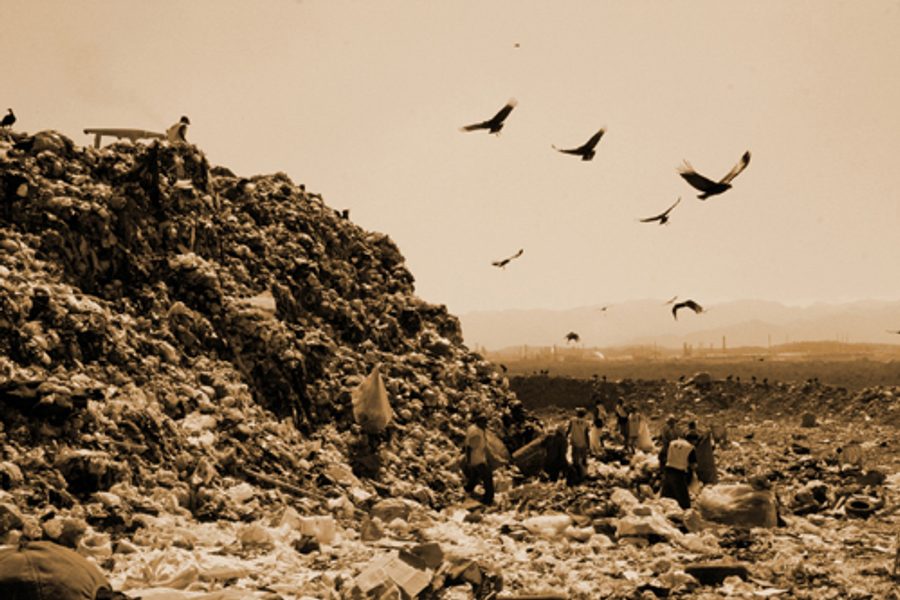
When Brazilian artist Vik Muniz describes the new piece he is about to embark upon in a massive Brazilian dump, as captured in the award-winning new documentary Waste Land, he notes that the people who live and work there are like the very refuse they comb through: “garbage.”
He is talking about how society views the catadores – trash-pickers, or rather collectors of recyclable materials. But early in the film, which the ambiguity of whether he’s critiquing society or simply offering his own view is a bad sign.
The Sundance and Berlin film festivals’ award-winning film has been featured at festivals across the U.S. and around the world, most recently the Chicago Internationl Film Festival this month. Ultimately, Waste Land provides stunning cinematography and score (by Moby) while telling the story of a crew of completely lovable and physically gorgeous catadores who become Muniz’s subjects and collaborators in an exhibit –creating stylized larger-than-life portraits out of trash — that smashes Brazilian museum attendance records and travels the world.
Unfortunately the sensory and sentimental brilliance of the film goes completely unmatched in the political/social context arena. The existence of people who live and work in dumps in developing countries — doing grueling, dangerous, piece-work labor picking through the toxic discards of materialistic global societies — is of course highly symbolic in a number of ways.
The theme has been mined by photographers, journalists and activists including Luis Alberto Urrea in his book Across the Wire about a Tijuana dump society.
Also Misty Keasler and Charles D’Ambrosio in their collaboration in a Guatemala City dump. In her book Gone Tomorrow, Heather Rogers takes on the concept of garbage in an even broader socio-political context.
But the working conditions, political realities and social symbolism of Jardim Gramacho, the world’s largest landfill, and the people who live and work there is only lightly brushed upon in Waste Land. The film is largely an overly congratulatory celebration of Muniz himself, and while he makes much of his growing fondness for the catadores and his vision of a participatory project, the visually stunning pieces they create fail to mine the rich experiences of the catadores themselves.
To his credit Muniz clearly wants to and aims to make a lasting change in the catadores’ lives, and the money from the sale of the art works ultimately does infuse greatly beneficial resources into the pre-existing catadores workers association.
But Muniz muses naively that perhaps catching a glimpse of a larger and brighter world through the art project experience will in itself be enough to inspire them to change their lives – a shockingly naïve remark considering the mammoth economic and political forces that weigh down upon even the most enterprising and ambitious poor people in highly-stratified Brazilian society.
Muniz wavers between highlighting generations of catadores and then saying most of them were lower middle class people – like his own youthful self – who essentially landed in the dump through bad luck. He and his colleague debate how the catadores really feel about their position, at first observing that it “doesn’t seem that bad” and that they seem quite happy with their work; but later realizing that most long for a different way to make a living.
There is of course dignity and camaraderie in such labor even as grueling and filthy as it is. But the film completely fails to mention any of the devastating environmental health effects of such work, even when one of the central characters dies of lung cancer, or when another works while pregnant amidst trash rife with heavy metals and other contaminants. At least the film briefly shows a catadores’ protest at a government building and mentions the catadores’ fight against government plans to close the landfill (in 2012, to avert an environmental disaster). But otherwise the surely rich and fascinating politics of the catadores workers association are ignored.
Ultimately Muniz grows on the viewer as a clearly affable, well-intentioned and relatively down-to-earth man, perhaps a rarity among artists of his renown; and it is heart-warming to see the catadores enjoy the creation and sale of Muniz’s pieces and use the profits to better their lives. So the film cannot be condemned and can be enjoyed for what it is. But given the potential richness of the subject matter, it is a stark disappointment for what it is not.
Kari Lydersen is a Chicago-based journalist, author and assistant professor at Northwestern University, where she leads the investigative specialization at the Medill School of Journalism, Media, Integrated Marketing Communications. Her books include Mayor 1%: Rahm Emanuel and the Rise of Chicago’s 99%.








